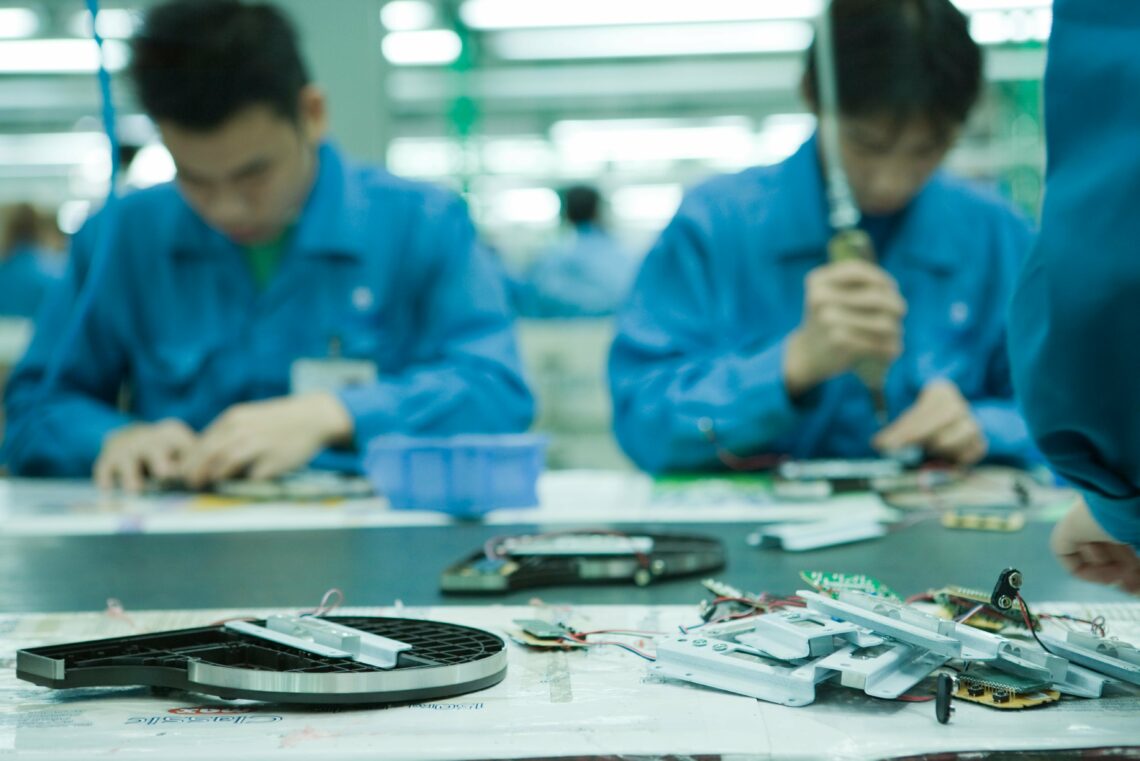The geopolitical implications of the microchip race
The semiconductor industry has become a matter of crucial geopolitical importance for the United States and China. Both countries are acutely aware that the outcome of the microchip race will give the winner a hefty advantage in the unfolding great power competition.

In a nutshell
- The semiconductor industry is becoming a political tool
- China will be hampered by its dependence on foreign parts
- China could pull ahead in the microchip race by leveraging its political power
Earlier this year, the United States’ Commission on National Security and Artificial Intelligence issued a report concluding the following:
“The United States lacks domestic facilities capable of producing, integrating, assembling, and testing microelectronics at scale…. This lack of access forces the [U.S. government], as well as the U.S. defense industrial base and other commercial U.S. firms, to rely on foreign fabrication and complex global supply chains for production, which increases risks to product integrity and exposes U.S.-developed intellectual property (IP) to theft…. This gap should provoke a “graceful and considered kind of panic” among U.S. policymakers.”
It seems policymakers got the message.
Facts & figures
Microprocessor companies
Semiconductor companies can be divided into three groups: chip manufacturers, nonfabricating chip designers, and chip equipment providers.
Chip manufacturers
Chip manufacturers can design and build microprocessors in their own fabrication plants, or “fabs.” There are approximately 30 of these companies, with the largest by market capitalization being Taiwan Semiconductor Manufacturing Company (TSMC), Intel, and Texas Instruments, in descending order.
Nonfabricating chip designers
Nonfabricating chip designers are semiconductor companies that outsource the manufacturing of their chips to other companies. There are approximately 31 of these “fabless” designers, led by Nvidia, Broadcom, Qualcomm, and Advanced Micro Devices (AMD).
Chip equipment providers
Finally, chip equipment providers neither design nor manufacture semiconductors, but provide the sophisticated equipment necessary for these processes. There are 34 of these companies, with the leaders being ASML, Applied Materials, and Lam Research.
While the semiconductor industry is largely centered in Asia, U.S. firms hold 47% of the global sales market, followed by Korea (19%), Japan (10%), Europe (10%), Taiwan (6%), and China (5%).
Semiconductors are generally identified by their transistor density, with increases occurring in “generations” or “nodes.” These nodes correspond to the transistor size – measured in nanometers (“nm”). The latest generation of chip (i.e., the smallest) is 5nm and is currently in prototype production. The current leading chips in mass production are 7nm and 10nm.
In July, INTEL announced that it would not be able to produce 7nm chips until late 2022 or early 2023 – nearly a year later than its original projections. TSMC, meanwhile, is scheduled to have its 3nm chips available in the same time frame.
Earlier, INTEL had experienced a multiyear delay with its 10nm process, allowing TSMC, AMD, and others to assume node leadership and, increasingly, market leadership.
Vital semiconductors
In late July, the U.S. Senate amended the 2021 National Defense Authorization Act – the annual spending bill for the Pentagon – to include a provision that, among other things, provides $22 billion for the American semiconductor industry.
The original author of this provision, U.S. Senator John Cornyn, advocated for the measure, saying that “ensuring our leadership in the future design, manufacturing, and assembly of cutting-edge semiconductors will be vital to United States national security and economic competitiveness.”
Semiconductors are now a constrained resource essential to a nation’s economic and technological development.
Critics of such measures argue the U.S. is, at best, overreacting to the economic rise of China, or, at worst, practicing a type of industrial policy that undermines global free trade and competition.
The reality, however, is that semiconductors (commonly known as microprocessors, microchips, or chips) are now a constrained resource essential to a nation’s economic and technological development. Both the U.S. and Chinese governments are currently building up their manufacturing capacity for strategic aims.
The importance of chips
Advanced semiconductors are the beating heart of personal computers, smartphones, vehicles, digital assistants, Internet of Things (IoT) devices, and virtually every other electronic device. They are especially important for artificial intelligence (AI).
Between the 1960s and the 2010s, general-purpose semiconductors have doubled their transistors while shrinking their overall size roughly every two years. Now, however, with state-of-the-art transistors being only several atoms wide, this evolution appears to be slowing. This is important because AI applications are ravenous when it comes to data processing power and speed.
The most common AI chips are application-specific integrated circuits (ASICs), field-programmable gate arrays (FPGAs), and graphics processing units (GPUs). The AI-optimized features of these chips accelerate the calculations required by AI algorithms, enabling them to do large numbers of calculations in parallel rather than in sequence. This, in turn, allows AI technologies to use fewer transistors while speeding up memory access.
Put simply, AI currently requires specialized microprocessors to perform its most consequential and promising applications – including those forming the future foundation of national security and economics. But these particular chips are extremely difficult to make.
There is only one company in the world that makes the machines essential for building advanced chips.
Advanced chips are designed mainly by Advanced Micro Devices (AMD), Broadcom, Intel, Qualcomm, Samsung, and Taiwan Semiconductor Manufacturing Company (TSMC). But when it comes to actually making the chips, TSMC dominates. The company accounts for more than 50 percent of the global market, while U.S. companies constitute only 12 percent of global manufacturing. Moreover, there is only one company in the world – the Netherland’s ASML – that makes the photolithography machines essential for building advanced chips.
All of this means the global microprocessor industry is gaining in strategic importance while being increasingly constrained by high research, design, and manufacturing costs.
Center of gravity
Semiconductors will enable virtually every technology shaping our collective future, from fifth-generation wireless networks to hypersonic missiles. This means that any nation seeking to ensure its ability to realize and benefit from these technologies must think about how it will guarantee access to these chips – even in the face of economic or geopolitical disruption.
Certainly, this is front of mind for Washington and Beijing.
As their Made in China 2025 strategy and other plans make clear, the Chinese Communist Party (CCP) has concluded that having a domestic capability to design and manufacture critical technologies is a prerequisite for realizing their national ambitions.

Washington, likewise, understands that making its own semiconductor supply chains more resilient is essential for its national security and economic competitiveness, as is stopping (or at least slowing) the development of domestic Chinese capacity for advanced chip design and manufacturing. The American urgency for keeping the lead in the microchip race by securing supply chains is further underscored by a growing awareness of how China uses its “private” companies as extensions of the CCP’s espionage capacity.
Scenarios
Chinese efforts thwarted
The first, highly probable scenario is that China will not pull ahead in the microchip race in the near-to mid-term by its dependency on foreign chip manufacturing.
In 2014, the CCP announced its China Integrated Circuit Industry Investment Fund (nicknamed the “big fund”), which would seed China’s domestic semiconductor industry with more than $19 billion in government aid. The fund’s goals were to domestically produce 40 percent of chips used by Chinese companies by 2020 and 70 percent by 2025. Some headway has been made.
In 2019, China’s microchip industry grew by more than 14 percent while the global industry shrunk by 13 percent. Between 2017 and 2020, at least 60 new chip plants are expected to go into production worldwide, with 40 percent of those located in China. But effort is not synonymous with effect.
Currently, Beijing’s domestic chips are assessed to be at least one generation behind Western state-of-the-art chips. American opposition is certainly slowing China’s advancements.
In 2015, 2016, and 2018, Chinese attempts to acquire foreign chip companies or technologies were blocked by the U.S. or its allies. Perhaps one of the most significant blows came just weeks ago, when Washington convinced TSMC not to provide its advanced chipsets to the Chinese telecommunications behemoth Huawei – effectively cutting the company off from its primary supplier.
Similar measures are likely to continue for the foreseeable future and will center around preventing Beijing’s access to critical semiconductor manufacturing equipment like the aforementioned photolithography machines. The supply chain for this equipment is so limited that it is an obvious target for Western export prohibitions and sanctions.
China overcomes the West
A second, medium-probability scenario is that China will overtake the West in the microchip race through innovation or by fracturing opposition.
While Chinese domestic chips appear to be lagging in sophistication, national champions like Baidu, Alibaba, Tencent, and others are keen on ensuring their access to cutting-edge chips and are likely actively supporting the CCP’s continuing investments. Several foreign leaders in semiconductor technology have joined Chinese companies and will likely push their efforts forward, including Yukio Sakamoto, the former CEO of Japan’s Elpida Memory, and Charles Kao, often referred to as the “godfather” of Taiwan’s chip industry. This influx of resources and talent could allow China to rapidly innovate so that they achieve their microchip objectives despite Western opposition.
It is also possible that China could sway the microchip race in its favor by leveraging its considerable influence to convince non-Western companies to continue supplying essential goods and services. The CCP is well versed in using coercive economic and political strategies to get what it wants. TSMC, for example, may technically be outside of Mainland China’s grasp, but its geographic and economic proximity alone means that the decision to withhold chips from Beijing will be met with severe pressure – including threats of military action.
Microprocessors, and especially AI-optimized chips, have become a matter of crucial geopolitical importance for the U.S and China. It is no overstatement to say that a nation’s ability to design and manufacture advanced chipsets will ultimately dictate its ability to determine its long-term national and economic security.







